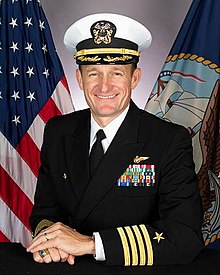
Commodore Anil Jai Singh, IN (Retd)
New Delhi. 08 April 2020. The recent news about the spread of the COVID-19 pandemic on the USS Theodore Roosevelt and the removal of its Commanding Officer, Captain Brett Cozier, (an experienced naval aviator who has served extensively on aircraft carriers, has been the Executive officer of USS Ronald Reagan and commanded USS Blue Ridge prior to taking over the Roosevelt) has rekindled the debate amongst naval veterans and professionals across the world on the accountability and indivisibility of command. The jury is out on whether the Commanding Officer’s action was justified and necessitated by the US Navy’s senior leadership not having done enough till then to provide him the re-assurance and support that should have been forthcoming under these very exceptional and trying circumstances. Was his removal from command meant to set an example and sending a message to the rest of the Navy or was it to cover up the inadequacy of the command and control ashore at all levels including the office of the Secretary of the Navy.
It also raises the question of whether he has been removed for addressing his mail to 20 people or for its appearance in the media? In the absence of any first- hand information , one should reserve judgement on this incident but it does bring to the fore aspects of Naval command and control and where exactly does the buck stop ?
In the navy, the responsibility and accountability of command is absolute and indivisible. It has been immortalised in the words of Joseph Conrad, “He is the Commanding Officer. He is the ship!” These words are ingrained in every naval officer’s psyche from the day one dons the uniform and is re-emphasised at every stage thereafter. Therefore, it becomes part of a Commanding Officer’s DNA. In navies all over the world, there are numerous instances of brilliant careers getting prematurely terminated when in the highest traditions of command, Commanding Officers have taken complete responsibility for their ships. However, there have also been enough instances where lesser men have risen to great heights by either deflecting the blame or where the organisation itself has supported them in doing so. While the former have earned the undying respect of their peers and subordinates, the latter have often taken refuge behind their stars and stripes to demand this respect.
However, aberrations notwithstanding, the majority of those who have donned the uniform and been appointed in command of ships and submarines believe in the indivisibility of command and acknowledge that with humility and responsibility. They are able to convey to the men they command the confidence that their Captain’s shoulders broad enough to shield them from any storm. The crew expects that the Commanding Officer will be true to them and will stand by them without fear or favour. In return, they offer their complete loyalty, sincerity, professionalism and unwavering commitment to the ship and its mission. This unspoken covenant between a Captain and his crew has withstood the test of time and has led to glorious chapters being written in the annals of naval history.
The Commanding Officer, on his part is duty bound to report any issue of concern on the ship which he believes merits external assistance or is beyond his powers to address to the next superior officer ashore or afloat. This could be a Division Commander, a Flotilla or Fleet Commander and could go right up to the Commander-in-Chief. Not doing so would infact amount to dereliction of duty. This obviously does not absolve the Commanding Officer of his responsibility to his ship and he must continue to do whatever may be in his power to solve or suitably address the issue.
It is for the superior officer to provide the CO with the support and assistance that he requires or advise him on a possible course of action. If necessary, the problem may need to be referred to the next higher level in the chain of command and could go up all the way to the Commander-in-Chief.
It is important that the Commanding Officer who is faced with the problem and is responsible to his crew for its satisfactory resolution must be kept in the loop and should have the confidence that his concern is getting the attention it deserves.
In the case of the USS Theodore Roosevelt, it is unlikely that an experienced Commanding Officer of a 100,000 ton aircraft carrier would under normal circumstances raise a trivial issue or allow emotion to get the better of good judgement and pragmatism. In this case, he obviously felt that he had raised a serious issue ( which indeed he had) and it was not getting enough traction. A COVID 19 positive case had been reported by the ship and on March 26 itself the acting Navy Secretary ( Thomas Modly) had acknowledged that there were 8 confirmed cases on board the ship of whom five had been evacuated. Hence that more cases would follow was not exactly rocket science; infact after the ship entered Guam the crew was not allowed to go beyond the pier.
The letter from the Commanding Officer which has raised a storm and has resulted in his removal was written four days later (on 30 April) by which time the cases on board had more than quadrupled ( which as of 03 April had exceeded 100). The Acting NAVSEC Secretary who is taking full responsibility for the removal of the Commanding Officer himself believes that “hundreds” more could be affected. In the four days between 26th when the Navy Secretary first went public and the 30th when the Commanding officer wrote the letter, he was obviously not convinced that enough was being done. The CO correctly highlighted that with the inadequate facilities on board, the cramped living spaces and close proximity of the crew to one another and a crew of 5000, the situation on board could well become unmanageable. He suggested that since the country was not at war, it was not worth jeopardising lives on board and the ship should be evacuated. In his response it is evident that the acting NAVSEC found this unacceptable. However, in the three days following his letter, over a 1000 sailors were evacuated from the ship and upto 2700 will eventually be evacuated. The ship is berthed alongside and will not be operationally available for at least a fortnight. Perhaps the Commanding Officer therefore stands vindicated but a political ego has got ruffled.
The Commanding Officer has been removed by the acting SECNAV (who has taken credit for it being his decision) for exercising poor judgement in writing that letter which got leaked and not following the chain of command. It begs the question as to what would drive a Commanding Officer of Captain Cozier’s experience to write such a letter and run the risk of jeopardising his career and possible Flag rank? Perhaps he was compelled to write because the chain of command including his immediate superior, the carrier Strike Grpup Commander ( a 1-star Admiral) embarked on the same ship and other senior Flag Officers) had also displayed an error of judgement in not fully appreciating the Captain’s concern at the magnitude of the problem.
A formal enquiry into the incident which is in progress will hopefully bring out the facts and put the entire incident in perspective. In a nutshell though, a promising naval career has been sacrificed at the altar of officialdom but the Commanding Officer will be able to look himself in the eye fully convinced that he did the right thing by his crew.
However, the purpose of this article is not to be judgemental about who is right or who is wrong but it raises certain important questions about command and its responsibility. Was Captain Cozier right in highlighting his concern about jeopardising the health and welfare of the men and women under his command ? Was the establishment at fault in not paying adequate attention to his concerns quoting operational preparedness as an excuse at a time when war is definitely not imminent. Did his operational commanders right upto the level of the CinC of INDO-PACOM reassure him adequately that they were doing their very best to assuage his concerns ?
If the Captain is being blamed for bypassing the chain of command why was the NAVSEC’s Chief of Staff in direct communication with the Captain and bypassing the very same operational chain of command?These and many other questions need to be answered because it brings to the fore the deficiency in the organisation when it fails to address incidents such as these caused due to extraordinary circumstances. Both, the Commanding Officer and the establishment believe that they did the right thing and the actions of both probably have their merits and demerits.The Theodore Roosevelt incident has raised some fundamental leadership issues relating to command in general and command at sea in particular. Valuable lessons can be learnt from this and it could even be included as a case study in naval leadership schools.
Post Script : As we go to press the saga gets murkier and the acting secretary of the US Navy Thomas Modly has resigned amid uproar over his handling of a coronavirus outbreak on the aircraft carrier USS Theodore Roosevelt .
(Commodore Anil Jai Singh is a former submariner. He did five afloat command tenures including four submarine commands and a Fleet ship command. He is the Vice President of the Indian Maritime Foundation and can be reached at ajaisisingh59@gmail.com, and @AJS_subdriver)


























































































































